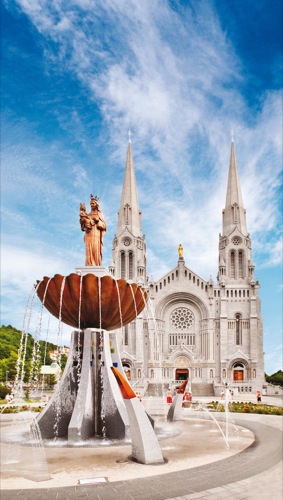
Sainte-Anne-de-Beaupre
Photo by Francois Marie Heraud, courtesy Quebec National ShrinesWooden crutches of various sizes hung crammed together form a wall of miracles in St. Joseph’s Oratory in Montreal, Canada. These simple crutches proved more moving to me than any of the oratory’s elaborate adornments. People had given the crutches to the oratory after having been inexplicably healed through prayer. I loved imagining people happily donating their crutches once they no longer needed them.
The crutches seem a tangible sign that God hears our prayers and can respond with miracles. What could be more meaningful than that? I spent a while thinking of the deep-rooted faith that brought relief to believers who suffered with physical ailments.
St. Joseph’s Oratory proved to be only the first emotionally powerful site I encountered on my tour of Quebec’s four national shrines. Our Lady of the Cape Shrine, St. Anthony’s Hermitage, the Basilica of Sainte-Anne-de-Beaupre and St. Joseph’s Oratory form an unforgettable pilgrimage that was both historically significant and deeply personal to me.
Miracles in Montreal
“Mark Twain once said, ‘If you throw a brick up in the air in Montreal, you will hit a steeple,’” said Marie Jose Pinsonnault, manager of the media and leisure market for Tourism Montreal. “And it’s still quite true. We have so many historic churches in Montreal.”
To prove this point, my first stop in Montreal was St. Joseph’s Oratory, perched above the city on Mount Royal. The imposing site was designated a shrine because of the miracles performed by St. Andre Bessette, otherwise known as Brother Andre.
No one could have guessed that an illiterate orphan — initially rejected by the Congregation of the Holy Cross due to frail health — would come to pray for the healing of thousands of people. However, Brother Andre’s reputation for miracles quickly spread, bringing people from all over to ask him to pray for them.
“The sick and injured wanted to pray with Brother Andre,” said Karine Gagnon, tour guide at St. Joseph’s Oratory. “On a busy day, he would see 200 to 300 people. Even when he was in the hospital, people would come and ask for prayers.”
I visited not only the cavernous oratory but also Brother Andre’s original chapel, an exhibit on his life and the Crypt Church where the saint escaped for quiet.
After leaving Montreal, I went to Trois-Rivieres. This charming river town sits at the confluence of the St. Maurice and St. Lawrence rivers. I followed Joseph, a tour guide dressed in 1920s period costume, on a walking tour of the town. As we passed the historic brick and stone buildings, Joseph helped me picture the early settlers trying to find a place to call home.
“Imagine this: You want to find a place to live,” said Joseph. “The French came to live in America, and they looked for a fur-trading route. Here, you were high enough to see any enemies coming by river. So they settled here in 1634, making it one of the oldest French settlements in North America.”
During the tour, I learned about the town’s original settlers, its Ursuline community, and the 1908 fire that wiped out the downtown.










